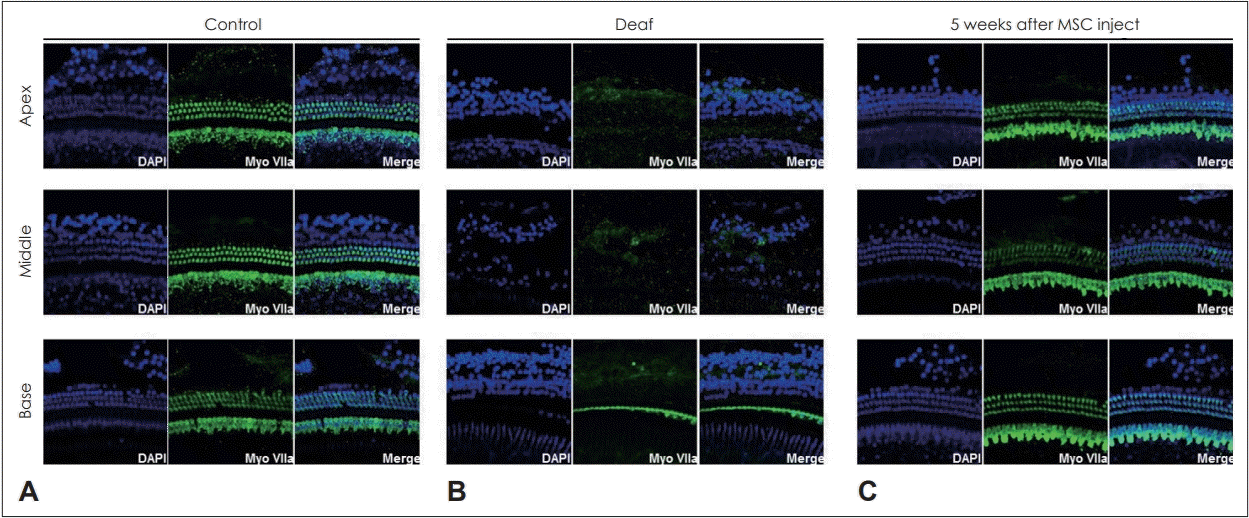1. Ganesan P, Schmiedge J, Manchaiah V, Swapna S, Dhandayutham S, Kothandaraman PP. Ototoxicity: A challenge in diagnosis and treatment. J Audiol Otol. 2018; 22(2):59–68.

2. Javadi MR, Abtahi B, Gholami K, Safari Moghadam B, Tabarsi P, Salamzadeh J. The incidence of amikacin ototoxicity in multidrugresistanttuberculosis patients. Iran J Pharm Res. 2011; 10(4):905–11.
3. Sagwa EL, Ruswa N, Mavhunga F, Rennie T, Leufkens HG, Mantel-Teeuwisse AK. Comparing amikacin and kanamycininduced hearing loss in multidrug-resistant tuberculosis treatment under programmatic conditions in a Namibian retrospective cohort. BMC Pharmacol Toxicol. 2015; 16:36.

4. Mahla RS. Stem cells applications in regenerative medicine and disease therapeutics. Int J Cell Biol. 2016; 2016:6940283.

5. Rybak LP, Ramkumar V. Ototoxicity. Kidney Int. 2007; 72(8):931–5.

6. Choi MY, Yeo SW, Park KH. Hearing restoration in a deaf animal model with intravenous transplantation of mesenchymal stem cells derived from human umbilical cord blood. Biochem Biophys Res Commun. 2012; 427(3):629–36.

7. Ahmadi N, Razavi S, Kazemi M, Oryan S. Stability of neural differentiation in human adipose derived stem cells by two induction protocols. Tissue Cell. 2012; 44(2):87–94.

8. Sharif S, Nakagawa T, Ohno T, Matsumoto M, Kita T, Riazuddin S, et al. The potential use of bone marrow stromal cells for cochlear cell therapy. Neuroreport. 2007; 18(4):351–4.

9. Hernández R, Jiménez-Luna C, Perales-Adán J, Perazzoli G, Melguizo C, Prados J. Differentiation of human mesenchymal stem cells towards neuronal lineage: Clinical trials in nervous system disorders. Biomol Ther (Seoul). 2020; 28(1):34–44.

10. Zaminy A, Shokrgozar MA, Sadeghi Y, Noroozian M, Heidari MH, Piryaei A. Mesenchymal stem cells as an alternative for Schwann cells in rat spinal cord injury. Iran Biomed J. 2013; 17(3):113–22.
11. Goutman JD, Elgoyhen AB, Gómez-Casati ME. Cochlear hair cells: The sound-sensing machines. FEBS Lett. 2015; 589(22):3354–61.

12. Okano T, Kelley MW. Stem cell therapy for the inner ear: Recent advances and future directions. Trends Amplif. 2012; 16(1):4–18.
13. Groves AK. The challenge of hair cell regeneration. Exp Biol Med (Maywood). 2010; 235(4):434–46.

14. Kil K, Choi MY, Kong JS, Kim WJ, Park KH. Regenerative efficacy of mesenchymal stromal cells from human placenta in sensorineural hearing loss. Int J Pediatr Otorhinolaryngol. 2016; 91:72–81.

15. Hakuba N, Hata R, Morizane I, Feng G, Shimizu Y, Fujita K, et al. Neural stem cells suppress the hearing threshold shift caused by cochlear ischemia. Neuroreport. 2005; 16(14):1545–9.
16. Matsuoka AJ, Kondo T, Miyamoto RT, Hashino E. Enhanced survival of bone-marrow-derived pluripotent stem cells in an animal model of auditory neuropathy. Laryngoscope. 2007; 117(9):1629–35.

17. Jeon SJ, Oshima K, Heller S, Edge AS. Bone marrow mesenchymal stem cells are progenitors in vitro for inner ear hair cells. Mol Cell Neurosci. 2007; 34(1):59–68.

18. Cho YB, Cho HH, Jang S, Jeong HS, Park JS. Transplantation of neural differentiated human mesenchymal stem cells into the cochlea of an auditory-neuropathy guinea pig model. J Korean Med Sci. 2011; 26(4):492–8.







 PDF
PDF Citation
Citation Print
Print




 XML Download
XML Download